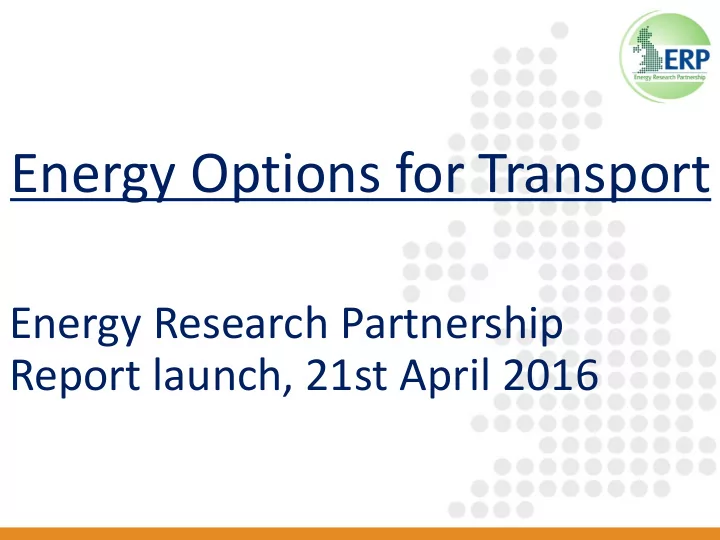

Energy Options for Transport Energy Research Partnership Report launch, 21st April 2016
Key messages Energy Research Partnership • Range of options can cut road GHG emissions – Impacts will depend upon technology mix and timings • Decisions must weigh up strategic considerations • Interactions with wider energy sector: • alternative uses of limited low-carbon energy resources • primary energy consumption and security of supply • Transport options offer different balances of: • effort of deployment • confidence of performance • Steps can be taken to – aid deployment and ensure performance – manage implications
Scenarios for road transport Energy Research Partnership • Three scenarios considered: – ICEVs with carbon-based fuels – BEVs with low-carbon electricity – FCEVs with hydrogen • Scenarios are not exhaustive, and are used to: – consider potential for ~80% GHG cuts (well-to-wheel) – highlight implications, and steps needed for delivery
Scenario 1: ICEV Evolution Energy Research Partnership Compared to 1990 Compared to 1990 • Key points: – reduce energy consumption – use liquid bio/synthetic fuels – use biogas used for HGVs – use electricity (PHEVs) to meet remaining demand
ICEVs: Steps required Energy Research Partnership • Research – New low-carbon drop-in liquid fuels especially for HGVs • Regulations & Incentives – Regulations to drive ICEV improvements – Incentives for advanced biofuels (& bio-gas) production – Incentives for optimal PHEV operation • Infrastructure decisions – Modify for high-blend fuels, and optimise fuel selection
Scenario 2: Electric Transition Energy Research Partnership Compared to 1990 Compared to 1990 • Key points: – potential depends upon segmentation of demand: – trip length is used for cars – road type is used for freight
Electric: Steps required Energy Research Partnership • Research – Improved battery performance (range or charging time) – Network trials, with third-party leadership where needed • Regulations & Incentives – Innovations for smaller freight operators’ logistics • Infrastructure decisions – Further grid decarbonisation – Higher generation capacity
Scenario 3: Hydrogen Transition Energy Research Partnership Compared to 1990 Compared to 1990 CO 2 production Compared to 1990 Compared to 1990 Higher-carbon grid mix • Key points: – No demand segmentation needed – Two main production methods (SMR & electrolysis)
Hydrogen: Steps required Energy Research Partnership • Infrastructure decisions (SMR) – Centralised SMR facilities – Repurposed low-pressure gas distribution networks • Infrastructure decisions (electrolysis) – Further grid decarbonisation – Higher generation capacity
All options: Steps required Energy Research Partnership • Research required: – Light-weight materials with reduced embedded impacts – Customers’ perceptions of light -weight vehicles – Impacts on demand due to automation • Infrastructure decisions: – Provide coverage of existing and emerging fuels – CO 2 pipelines & storage for range of energy options
Strategic considerations Energy Research Partnership Energy system interactions: • Wider decarbonisation – sectors’ GHG ambitions need to balance for UK target – multiple possible uses for limited resources • Energy consumption – new consumption profiles affect network operation – increased consumption changes supply chains – reliance upon fewer energy vectors for more of UK’s critical sectors could affect security of supply
Strategic considerations Energy Research Partnership Weigh up deployment and performance: • Effort of deployment – ICEVs require less new infrastructure than EVs or FCEVs • Performance (GHG) – harder to ensure for ICEVs (need regulations to drive technological gains) – easier to ensure for EVs and FCEVs (by focussing on upstream energy production) • Co-benefits – Reduced air and noise pollution with EVs and FCEVs – Resilience from dual-fuel operation with PHEVs
Strategic considerations Energy Research Partnership Questions of timings and costs: • Timings of infrastructure deployment – Some infrastructure needed for multiple scenarios (e.g. electrical for BEVs and ICEVs/PHEVs) – Earlier deployment could offer efficiencies with other projects, or later deployment could smooth workloads • Costs of options – Vehicles’ TCO expected to converge by ~2030 – But upfront costs affect customer decisions – Must be workable & affordable (perhaps not least-cost) – Customer decisions could set direction for infrastructure – Distribution of costs will be a policy judgement
Energy Options for Transport Energy Research Partnership Report launch, 21st April 2016
Recommend
More recommend